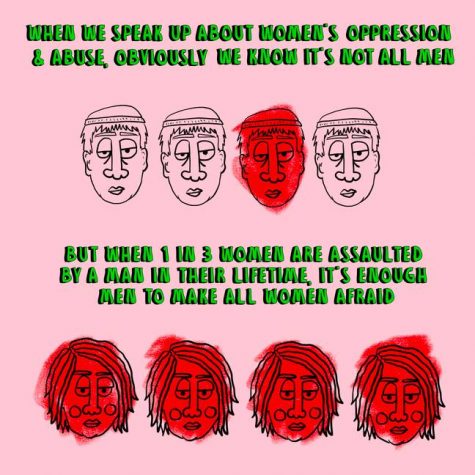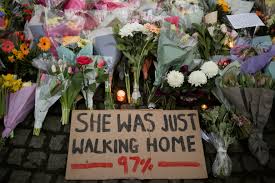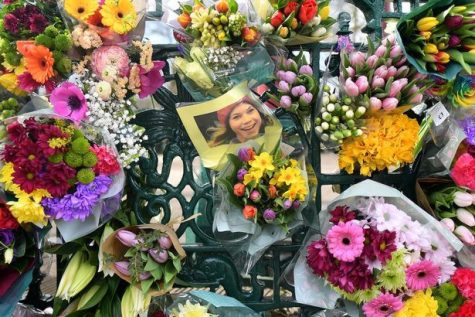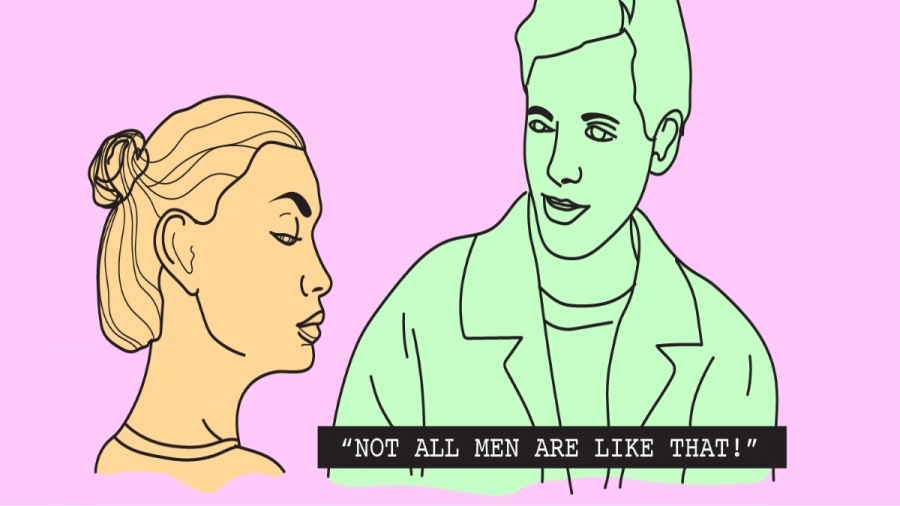“Not All Men”: A Discussion on Female Harassment
March 19, 2021
As human beings, we have a tendency to generalize things. For example, we tend to generalize that dogs are smarter than cats, that people who sleep-in are night-owls, homework is hard, the customer is always right, your family will always be there for you, etc. It’s a natural association process we use to condense what information we have so that it can be applied in new situations and environments. It’s like when we say, “be careful, that knife is sharp and will cut you”, no one ever says “not all knives are sharp enough to harm you”, because, in all actuality, we understand that even though a butter-knife is unlikely to cause us any damage, there are still plenty of sharp knives that can risk your well-being. This is where the phrase: “not all men”

comes in; it is a common rebuttal ushered by many in response to women opening up about their experience with assault, harassment, cat-calling, or rape. “Not all men are predators” “not all men are creeps” “not all men are dangerous”, and sure, that’s something that may be true because I’m sure we all have dads, brothers, sons, grandfathers, friends, cousins, and neighbors who are male, yet are completely harmless. However, when 97% of all women report they have been harassed, when 1 in 3 have been assaulted, and when 85% have been cat-called, it’s enough to generalize the idea that men make women afraid- and with femicide- the murder of women and girls particularly by a man on account of her gender- on the rise, it’s important to discuss why “not all men” is no longer a justified response, and how you can change the narrative.
Her name was Sarah Everard. She was only 33-years-old when she was murdered on March 3, 2021, by a
Metropolitan police officer in his house after proceeding to kidnap her on her way home from a friend’s house. What sticks out most about this case was that Sarah did everything right to get home safely, yet many are still blaming her for her death; she wore bright clothing, she took the quickest route home, she kept her boyfriend on the phone on her walk back, and she stayed towards well-lit areas. Sarah did everything society tells women to do if they don’t want to be

assaulted, harassed, or even murdered on their walk home- but the conversation should not be focused on what we should and shouldn’t be doing as women to keep ourselves safe- it should instead lend itself to opening up about why we as a society have perpetuated that women should have to be prepared to not die at the hands of another man while simply walking at night. Yet, Sarah’s story isn’t the only case like this; Sasha Marden was sexually assaulted and stabbed 58 times at the age of sixteen by another man, Judith Nibb was beheaded by her husband after 30 years of marriage, and plenty of other women- Dorothy Shepherd, Rita King, Angela Smeaton, Chloe Rutherford, Demi Pearson, Faye Isaac, Emma Baum, Heather Cooper, Joy Morgan were all be murdered for simply existing as a woman.
Recently, women from across the country have been pouring in with responses of how they choose to keep safe when going out: some said that when they ride in cabs they always make sure to leave strands of hair behind as DNA evidence just in case, others make sure they’re on the phone or pretend to be on the phone with someone to avoid uncomfortable situations (but let me point out that they ensured they always pretended to be on the phone with a dad or boyfriend because many women have come to learn that man only respects man), plenty have reported that they carry pepper spray, brass knuckles, and even their keys between their fingers when out to avoid being attacked. The question I would like to pose is how do we come up with an astonishing statistic that reveals that 97% of all women have been assaulted or harassed by a man before, yet as a collective, we see women as the problem here? Why do we teach women how not to get attacked, but don’t teach the attackers not to assault women? How has over half of all women in the US experienced sexual harassment, yet no one believes them? How does everyone know a woman who has been harassed but doesn’t know a man who has been a harasser?
The answer is simple, rape culture and the normalization of victim-blaming is at fault for ingraining the belief that women are always the ones at fault, and that we should be taught how to avoid being harassed rather than teaching men not to harass us in the first place. Women are not supposed to walk home alone at night but don’t get an uber or taxi because you could also be assaulted there. We aren’t supposed to dress too provocatively or we’re “asking for it”, but at the same time we also need to “leave something to the imagination.” We shouldn’t refuse to go out with a man because that’s “impolite”, but we also shouldn’t be so trusting. It all boils down to the plain fact that it’s never been about what women do or don’t do, it’s more that no matter WHAT we do, we will always be at risk for harassment because not enough men and boys are being taught how to be civil human beings.
I certainly do not blame all men, nor do I hate them at all, and leaving them out of this conversation will only

make problems worse. While “not all men” is a perfectly justified argument because though it may not be ALL men, it is ENOUGH men to make women fearful to dress in a certain way, be out at a certain time, make them need to carry protection, or call someone, etc. It may not be all men who commit these acts, but it is certainly all of their responsibility to tackle this crisis head-on. Whilst I was reading similar articles to get inspired a few days ago, I heard the best analogy that compared the statement “not all men” to a game of Russian roulette: In a game of Russian roulette there are six holes, but the bullet only resides in one of the spots. If given the chance to play, many of us would probably say no- and why? Because even though not every shot will be lethal, you still don’t know which could. Similarly, it is true that not all men pose a threat to women, but there is no way of pointing out who’s a normal average guy, and who’s a bad one looking to commit assault, and therefore all men will have to bear the burden of suspicion unless we begin to realize that the problem does not start with women like Sarah Everard walking home at night, but with a man who thought it was justified to assault and murder her.
There comes a point when it is not just enough for a man to not be a harasser because things like following women, invading their personal space, staring at them, and throwing uncomfortable comments at them is what we expect them not to do out of common courtesy and respect- what we also need is men to be ACTIVE bystanders, which means calling out your other male friends when they do the wrong things, not turning a blind eye when you see a woman being harassed and become educated on this growing issue. For far too long we have insinuated that assault and harassment was a woman’s issue because it’s directly affecting us, when in reality, for change it must begin to be viewed as a man’s issue all the same.
It is very clear that not all men are actively fighting against misogyny and violence against women.
*This opinion article reflects the voice of the writer and does not necessarily represent the views of The Viking Times as a whole. Like most news outlets, The Viking Times is a non-partisan media platform.**



